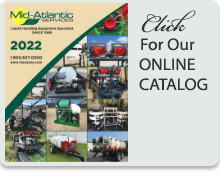Frequently Asked Questions
- How do I calibrate my sprayer?
- How do I winterize my spray pump?
- How do I select the proper nozzle for my spray job?
- How do I determine the proper orifice size for my sprayer when dribbling liquid nitrogen?
- How often do I change the oil in my pump crankcase?
- What oil do I use in the crankcase of my pump?
- My electronic rate controller doesn’t register proper gallons per acre or is sounding an alarm that the rate is off.
How do I calibrate my sprayer?
Improperly calibrated sprayers threaten the wallet and the environment. A few minutes spent calibrating a sprayer can ensure expensive inputs go where they are supposed to, and at their recommended rate. Proper calibration exposes under-pressured systems and worn tips that can sabotage a spray program and its budget. Follow these steps to calibrate your sprayer safely and effectively… Read More (PDF)
How do I winterize my spray pump?
It is important to winterize all spray pumps where any possibility of freezing due to low temperatures is expected.The procedure will differ according to the type of pump. All pumps should be thoroughly rinsed with clear water to remove all traces of spray materials. The following recommendations are for specific pumps listed.Roller & Centrifugal Pumps:Final flush pump with 50% mixture of water and permanent antifreeze containing a rust inhibitor. Drain pump and plug ports to keep air out.
Piston & Diaphragm Pumps:Final flush with 50% mix of water and permanent antifreeze. Drain crank oil and replace with 30 wt. non-detergent oil. Always change oil after replacing diaphragms.
If the above procedures are followed, it is a simple matter to re-commission the pump in the spring, since it will be ready to go. The only precaution is to be sure to prime centrifugal pumps well before running to protect the seal.
CAUTION: Permanent antifreeze is lethal to pets and children!
How do I select the proper nozzle for my spray job?
1. The first step in nozzle selection is determining rate in gallons per acre, gallons per thousand square foot or gallons per minute.2. Determine pressure you wish to spray by reading label of pesticide you are using.Generally, the lower the pressure, the less chance of drift.3. To determine the type of nozzle you can go to Spraying Systems Co “Spray Nozzle Selection Guide.” Here you can select the best type of nozzle for your application: Guide / Guide II
Next, go to the chart for the nozzle selected and find specific rates and pressures at desired speeds. If you are using nozzle spacing other than what is printed on the charts, you must determine gallons per minute for your specific speed and pressure using the following formula:
gal/min = gal/acre x swath(inches) x mph / 5940
Once you have gal/min you can look under that column of the nozzle chart and find the ideal pressure you would like to spray at and use the nozzle corresponding to it.
How do I determine the proper orifice size for my sprayer when dribbling liquid nitrogen?
By using the gal/min formula you can determine proper orifice size by plugging in all known factors in the formula. Here it is very important to know average speed desired to operate. The Spraying Systems chart for CP4916* flow regulators will let you select the right orifice.
Generally, you need a minimum of 10 psi to get equal division. However, that low a pressure doesn’t give you much room to slow down with. We recommend 30-40 psi as a general rule, but you can operate at pressures from 10 to 100 pounds if your pump and fittings will work in that range. *Contact us for additional information.
How often do I change the oil in my pump crankcase?
Most manufacturers recommend changing pump oil every year. On a positive displacement metering pump such as the CDS-JOHN BLUE, it is highly recommended that the oil is changed at the end of the season so that any contaminants entering the crankcase can be removed before sitting in the pump all winter.On a diaphragm pump such as the Hypro or CDS-John Blue, the same is recommended.
What oil do I use in the crankcase of my pump?
On diaphragm pumps, 30 wt non-detergent oil is recommended. On the CDS-John Blue metering pumps, the recommends 90 wt gear oil. However, we have found that when working in cold temperatures in the North, such as top dressing wheat in February and March, the heavier oil does not give good protection. We recommend 30 wt non-detergent oil and the engineers from John Blue have given us their approval on this.
My electronic rate controller doesn’t register proper gallons per acre or is sounding an alarm that the rate is off.
1. Check to see that proper constants are entered into the controller. They should be written down in your owner’s manual.2. Check to see that the controller is registering speed. If no speed is showing, then the problem may be in radar or GPS speed sensor or in the wiring for them.3. Flow control valve may be stuck in open position. This seems to happen more often after sitting all winter on initial start-up in the spring. Symptom will be sufficient tank pressure but little to no boom pressure. To correct the problem, place controller in manual mode and increase pressure. This should unstick (OPEN) the valve allowing system to work properly.
For additional information email: Mid-Atlantic Services or:
Call 800-637-0050

